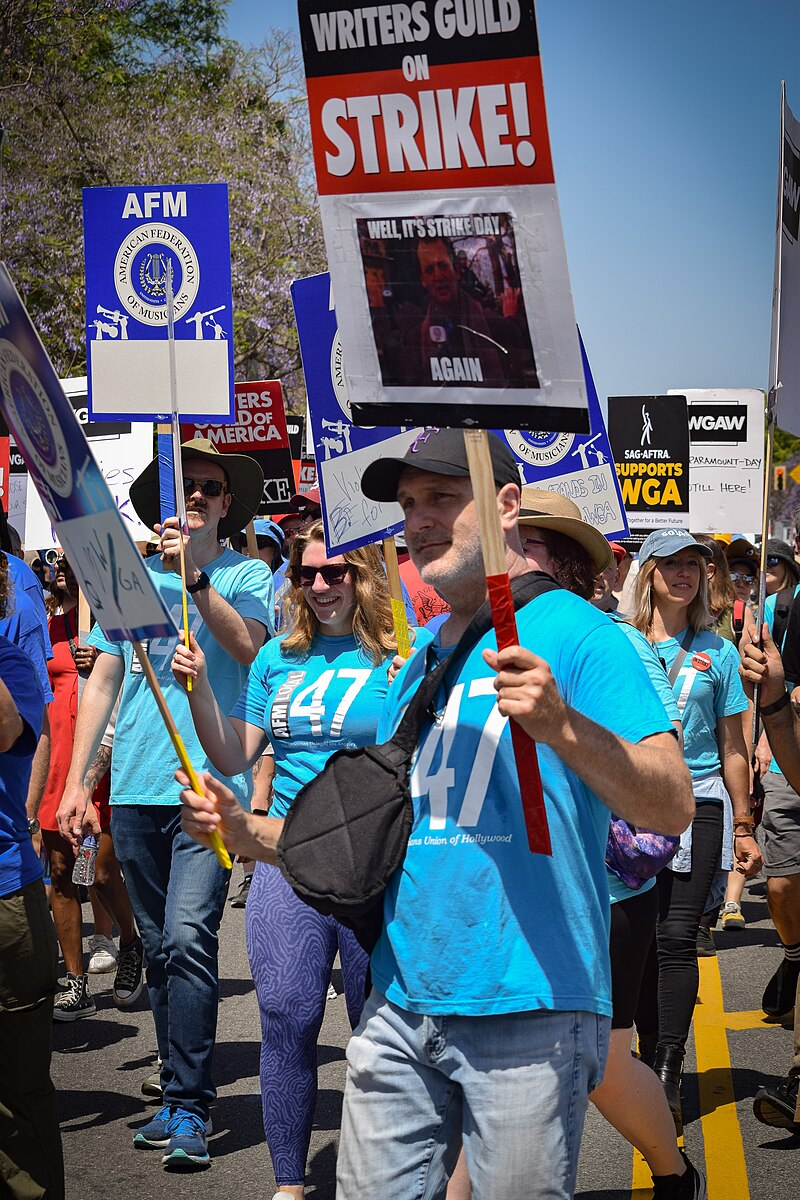Strikes have been seen throughout history as well as in popular media, films and musicals like “Billy Elliot” and “Newsies.” They’re used to unite a front of working individuals who are not receiving fair compensation and appreciation for their work. Strikes prove to be a history-making event, inspiring those taking part and those who look on from afar. Now, moving from the screen to real life — creatives and writers who created these artistic portraits of strikes that have inspired entertainment fans are enduring their own strike in Hollywood.
The Writers Guild of America (WGA) has been on strike for three months, with the Screen Actors Guild-American Federation of Television and Radio Artists (SAG-AFTRA) striking alongside the WGA since July 14. The WGA strike began on May 2 over an ongoing labor dispute with the Alliance of Motion Picture and Television Producers (AMPTP).
The WGA voted on April 18 that if satisfactory negotiations with the AMPTP were not met by May 1, they would be going on strike. This vote received a 97.85% approval rate, and because the WGA and the AMPTP failed to reach an agreement by the May 1 deadline, the strike began the following day.
The leading issue, out of many, that has caused the WGA to go on strike is the dispute over residuals, financial compensation that artists receive based on consumption of their work, from streaming media. According to the WGA, the rise of streaming media has led to drastically lower residuals for writers than those of traditional broadcast media. This is due to the latest Minimum Basic Agreement that the AMPTP established on May 2, 2020, which notes the minimum wage for film and television writers for broadcast television and not streaming television.
The WGA previously went on strike in 2007 after writers sought more compensation from large studios. Similar to the ongoing labor dispute, the 2007 strike was targeted specifically at the AMPTP and, at that time, the guild was on strike for a whopping 100 days.
As the WGA heads into its fourth month of striking, force majeure clauses allow big studios to terminate contracts with writers, complicating the conditions under which the strike began. Force majeure clauses entail a freeing between both parties within a contract due to outside events, such as labor strikes.
Two months after the WGA went on strike, SAG-AFTRA followed suit and joined the WGA to establish solidarity. The strike for the actors’ organization is historic as it marks the first time that both actors and writers have walked out simultaneously since 1960. In Manhattan, many union members on strike have formed picket lines outside of the NBCUniversal, Warner Bros. Discovery and Netflix buildings. Prominent celebrities including Matt Damon, Jennifer Lawrence, Margot Robbie and many more have voiced their support for the strike and SAG-AFTRA’s demands from AMPTP.
With the joint strikes now entering its 120th day, filmmakers and screenwriters continue to fight for their rights and residuals, hoping to change the landscape of Hollywood.
The reasons for the SAG-AFTRA strike were numerous: Similar to the WGA, they included residuals as well as the use of artificial intelligence in replacement of actors. According to Deadline, SAG-AFTRA cited several issues in their negotiations with the AMPTP. The issues included “economic fairness, residuals, regulating the use of artificial intelligence and alleviating the burdens of the industry-wide shift to self-taping.”
Both guild’s respective websites show messages of support and encouragement for one another. On SAG-AFTRA’s page, their guild wrote that “The time for change is now and we must be prepared to fight if management will not address our concerns.”
The joint WGA and SAG-AFTRA strikes are the biggest halt of production and movement within the film and television industry since the COVID-19 pandemic in 2020. The strikes seem to be at a stalemate, as the big studios have made no effort to respond to the ongoing strikes that are dominating the Hollywood industry.
According to Deadline, on Aug. 24, members of the WGA said that the AMPTP’s latest counteroffer for a new contract “is neither nothing, nor nearly enough.” The studios have begun to make strides in complying with the guild’s needs, but an agreement remains distant.
The best thing for film and television supporters and enjoyers alike is to support those striking, online and offline — attending picket line marches or donating to funds. Those in production for premiering work aren’t allowed to promote their films that fall under struck companies, due to SAG-AFTRA’s guidelines. However, cinephiles should continue to support current independent hits such as Emma Segilman and Rachel Sennott’s acclaimed “Bottoms” and Charlotte Regan’s “Scrapper” — shining light on the hundreds of artists who contribute to these worlds of storytelling and deserve to be compensated fairly for their work.
Studios have made the distinction that if AI was to write a film or series script, it will not be considered literary material seeing as AI cannot be defined as a “professional writer.” However, guild members say that the studios still “continue to refuse to regulate the use of our work to train AI to write new content for a motion picture.” Therefore, the integrity of a screenwriters’ work and creativity is still very much at stake. With the joint strikes now entering its 120th day, filmmakers and screenwriters continue to fight for their rights and residuals, hoping to change the landscape of Hollywood.
While the strikes has no near end in sight, members and nonmembers of the union continue to share their unwavering support for both the WGA and SAG-AFTRA, reminding everyone that supporting filmmakers and artists of the film and television industry is vital to fostering the magic that comes out of your favorite show, film and artistic community.

